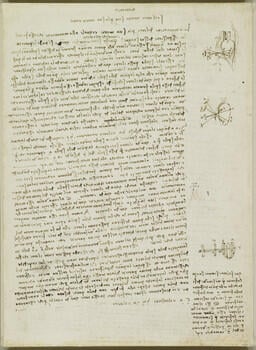The movement of the heart (recto); Notes on the movement of the diaphragm and the stomach, with diagrams (verso) c.1511-12
Pen and ink | 29.1 x 21.1 cm (sheet of paper) | RCIN 919065

Leonardo da Vinci (1452-1519)
The movement of the heart (recto); Notes on the movement of the diaphragm and the stomach, with diagrams (verso) c.1511-12


-
Recto: Three small diagrams showing changes in the position of a pig's heart as it is slaughtered, with accompanying notes:
Anatomy: Whether the heart changes its position at death or not
The change of the heart at death is the same as the change that it makes in the expulsion of the blood, or somewhat less. This is shown when they kill pigs in Tuscany, where they pierce the hearts of the pigs with an instrument called a spile, with which wine is drawn from casks. Turning the pig on its back and fastening it down firmly, they pierce its right side and its heart with this spile, pushing it straight inside. And if this spile pierces the heart when it is elongated, in its expulsion of blood the heart shortens and draws its wound upwards together with the point of the spile, and as much as it raises the point of the spile inside, so it lowers the handle outside. And then when the heart is distended and pushes its wound downwards, then the part of the spile outside makes a movement contrary to that of the part inside.... And this is does many times in such a way that at the end of life the external part of the spile remains in the middle between the two extremes which were the last contrary movements of the heart when it was alive... And this I have seen many times, and I have observed such measurements, and I have let such an instrument remain in the heart until the animal was cut up.
Leonardo goes on to discuss and illustrate how differing depths of penetration of the spile into the heart, and penetration at different moments in the cardiac cycle, affect the degree of movement of the handle. He thus deduces that the heart shortens and lengthens during the cardiac cycle, and that in death it comes to rest between these two extremes. It must be noted, however, that Leonardo does not describe here what we would recognise as systole (when the heart contracts, in all dimensions, to pump blood out) and diastole (when it relaxes and fills with blood); indeed further down the page he refers to ‘extension and dilatation’ (‘astensione e dilatatione’), suggesting that he believed that when the heart shortened, it grew correspondingly wider – that its shape changed but not its overall volume as it pumped blood backwards and forwards between the ventricles and atria.
(Text from M. Clayton and R. Philo, Leonardo da Vinci: Anatomist, London 2012)
Verso: Diagram of under-surface of diaphragm & of respiratory changes in shape of abdominal cavity; the oesophagus, stomach & duodenum; notes on the action of the diaphragm and the stomachProvenance
Bequeathed to Francesco Melzi; from whose heirs purchased by Pompeo Leoni, c.1582-90; Thomas Howard, 14th Earl of Arundel, by 1630; Probably acquired by Charles II; Royal Collection by 1690
-
Creator(s)
Acquirer(s)
-
Medium and techniques
Pen and ink
Measurements
29.1 x 21.1 cm (sheet of paper)
Other number(s)







